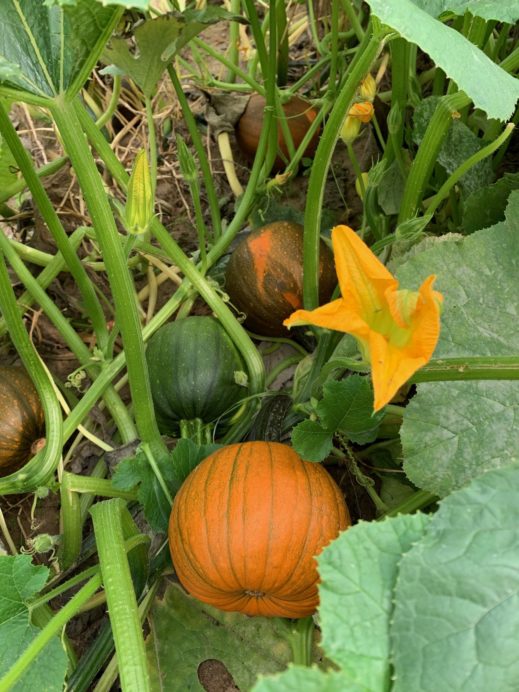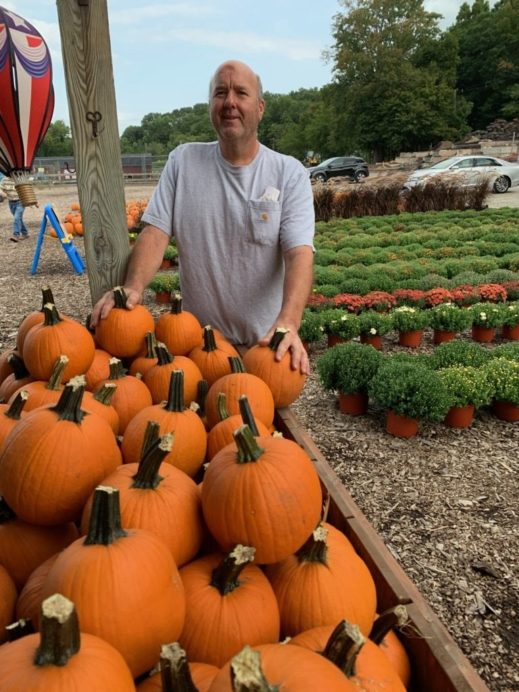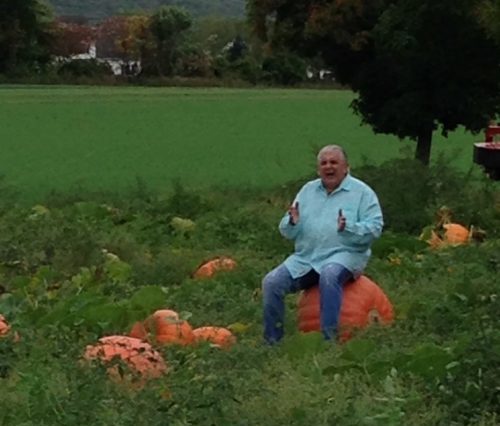
October is truly one of my favorite months of the year and there’s nothing more iconic in the Garden State at this time than corn mazes, hay rides and—especially—pumpkins. New Jersey devotes 2,000 acres to growing pumpkins and ranks in the top third of all states in terms of pumpkin production, with most of it consolidated in counties in Central and North Jersey, based on their greater population. Most varieties of pumpkin are planted in early June, harvested in September when they’re mature, and sold from October through December.
The opportunity to head out to a farm with the family to pick pumpkins or enjoy a hay ride is a great fall tradition that shouldn’t be missed. For a list of farms offering pumpkins or pick-your-own opportunities in your area, click here.

Pumpkins growing from flowers at Farms View in Wayne. Photo courtesy of Farms View
10 Fun Facts About Pumpkins
—The U.S. produces 1.5 billion pounds of pumpkins each year.
—Pumpkins are among the most nutritious of all produce, supplying more beta carotene per serving than any other fruit or vegetable.
—There are 45 different varieties of pumpkins.
—Pumpkins come in a range of colors, including orange, white, blue and green.
—All pumpkins are edible.
—Despite public consensus, pumpkins aren’t vegetables—they’re actually fruits.
—In 2018, a New Hampshire man grew the largest pumpkin ever recorded in U.S. history. Ot weighed in at 2,528 pounds, more than a ton!
—In 2010, New Bremen, Ohio was the site of the largest pumpkin pie ever made. It was over 20 feet in diameter and weighed nearly 3,700 pounds.
—Pumpkins usually have one flat side, which is where they lay while growing.
—Each pumpkin contains about 500 seeds.
Growing Pumpkins

Todd Kuehm of Farms View. Photo courtesy of Farms View
Pumpkins abound at Farms View in Wayne, a dual-location, 65-acre farm owned by the Kuehm family since 1894. “Pumpkins start as a seed and then turn into a flower,” says family member Todd Kuehm, who plants pumpkins from mid-June through early July. “Pumpkins take about two to three months to mature and some large varieties can grow as much as two pounds a day.”
Farms View sells thousands of pumpkins in the fall and offers 24 different varieties, including popular varieties, Magic Lantern, Bisbee Gold, Bay Horse Gold and Touch of Autumn, as well as interesting Fairytale, Mystic, Lunch Lady and white Snowball types. With residents from all over the state descending on New Jersey farms for their pumpkins at this time of year, “we operate several different patches at our farm so that people can enjoy picking their own pumpkins in a socially-distanced manner,” Kuehm says.
According to his sister Dana, “some people are in search of the most perfect pumpkin while others want the most unique or unusual one—it’s all up to one’s imagination.”
“It’s so nice when families come out to enjoy this season and we especially love the way kids’ faces light up when they get to see and pick pumpkins,” Todd adds. “That makes it all worthwhile for us!”
Selection, Storage, and Preparation
When picking any kind of pumpkin, select one without bruises or soft spots. It may be greenish in color, but if it’s left whole in a cool spot—not refrigerated—it will ripen and turn orange. Always select a pumpkin with a nice green stem (I always say that a pumpkin without a stem is like a Christmas tree without a star on top!), but avoid handling a pumpkin by its stem because it can break off easily.

Produce Pete shares information on pumpkins during a recent field segment on NBC Weekend Today in New York. Photo courtesy of Pete Napolitano/NBC
Some people use jack-o’-lantern pumpkins for cooking, but these were developed specifically to be oversized and thin-walled, with a huge seed pocket and a relatively small proportion of flesh. By contrast, the smaller sugar pumpkins, or pie pumpkins, will give you more meat for cooking purposes and often a better flavor and texture. Sugar pumpkins make an especially delicious pumpkin soup. For another interesting application, buy an extra sugar pumpkin, clean out the cavity, and use it as a fun fall tureen.
If you can find it, I suggest using a variety called cheese pumpkins for pies. They’re medium-to-large-sized pumpkins with very flattened shapes, a light tan shell, and orange flesh. Most readily available at farm stands, cheese pumpkins make delicious pies, while regular pumpkins —particularly sugar and especially jack-o’-lantern varieties—sometimes make a stringy filling.
Pumpkin meat is a great ingredient in soups, pies, baked goods and pasta. One of my favorite pumpkin-inspired foods is my wife Bette’s homemade pumpkin ravioli; it’s always a big hit in our house at this time of year and I know you’ll love it too!
Bette’s Best Pumpkin Ravioli
Filling
¾ cup pumpkin purée
½ cup ricotta cheese
1/3 cup grated parmesan
1 egg
½ teaspoon salt
¼ teaspoon nutmeg
Dash cinnamon
Dash ginger
Dash clove
Black pepper
Handful of bread crumbs
Sage Butter Sauce
1 teaspoon cornstarch
1 tablespoon cold water
1 cup chicken broth
2 teaspoons dried sage
3 tablespoons butter, cut in pieces, melted
In a small bowl, blend cornstarch with cold water. In a small pot, heat chicken broth over high heat and cook 3 minutes, or until slightly reduced. Add dried sage and cornstarch mixture and boil for 1 minute.
Remove pan from heat and swirl in butter until melted.
Homemade Ravioli
2 cups all-purpose flour, plus more for dusting
1½ teaspoons sea salt
3 eggs, plus 1 for egg wash
2 tablespoons olive oil
In a large bowl, whisk together the flour and salt. Make a well in the center of the flour, add in the eggs all at once and mix them together well using your hands. Add the olive oil and knead the dough for 5 minutes. Form into a ball and leave in the bowl, covered with plastic wrap for 30 minutes. Take a small piece of the dough and either run it through a pasta machine a few times or use a rolling pin, using some flour and muscle to create a thin sheet. Cut circles out of the dough using a cookie cutter or a glass. Place 1 teaspoon of the pumpkin filling in the center of half of the circles and lightly brush egg wash around the edge of the circle. Place the second circle on top over the filling and use a fork to crimp the edges all around. Continue with the remaining pasta dough until all of the dough and filling have been used.
To cook the ravioli, bring a large pot of salted water to a boil, add the ravioli, and cook for 2-3 minutes (they’re done once they float to the top). Drain, toss the pumpkin ravioli with sage butter sauce, and enjoy!
About “Produce Pete” Napolitano
With over 65 years of experience in the produce industry, New Jersey’s own “Produce Pete” Napolitano is a renowned fruit and vegetable expert, author, and television personality who’s appeared on a highly-popular segment on NBC’s Weekend Today in New York broadcast every Saturday mornings for over 27 years. For more information, visit Pete’s website.
About Susan Bloom
A contributor to New Jersey Monthly and a variety of other well-known local and national publications, Susan Bloom is an award-winning New Jersey-based freelance writer who covers topics ranging from health and lifestyle to business, food and more. She’s collaborated with Produce Pete on a broad range of articles for nearly a decade.
